The Importance of Teamwork and Collaboration in Organizations
VerifiedAdded on 2020/05/28
|19
|4436
|151
Essay
AI Summary
This essay delves into the significance of teamwork and collaboration within organizational settings. It explores the fundamental concepts of teamwork, defining it as the ability of individuals to work together towards common goals, and emphasizes the benefits of effective collaboration. The essay examines various scholarly perspectives on teamwork, including the distinction between different team types and the evolution of teamwork concepts. It also investigates the role of collaboration in teams, highlighting the importance of knowledge sharing and the challenges posed by privacy concerns. The research addresses the issue of whether privacy hinders collaboration and the development of high-performing teams. It also discusses the aims and objectives of encouraging proper teamwork and collaboration to achieve organizational goals. The literature review covers the concept of teams, teamwork, collaboration, and the impact of privacy on teamwork. The essay analyzes the views of various scholars and provides an analysis of the views of scholars regarding human’s ability to work in teams in collaboration with each other.
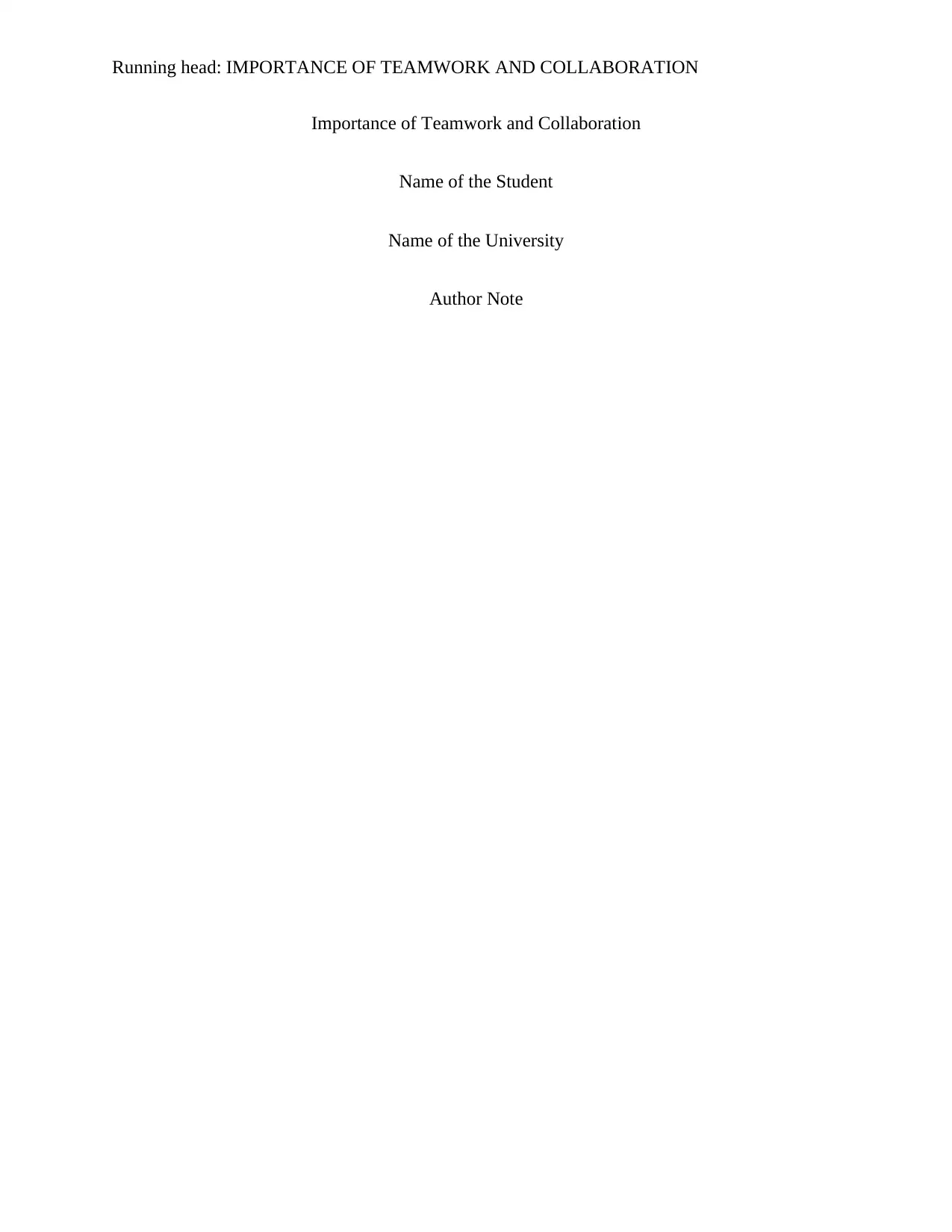
Running head: IMPORTANCE OF TEAMWORK AND COLLABORATION
Importance of Teamwork and Collaboration
Name of the Student
Name of the University
Author Note
Importance of Teamwork and Collaboration
Name of the Student
Name of the University
Author Note
Paraphrase This Document
Need a fresh take? Get an instant paraphrase of this document with our AI Paraphraser
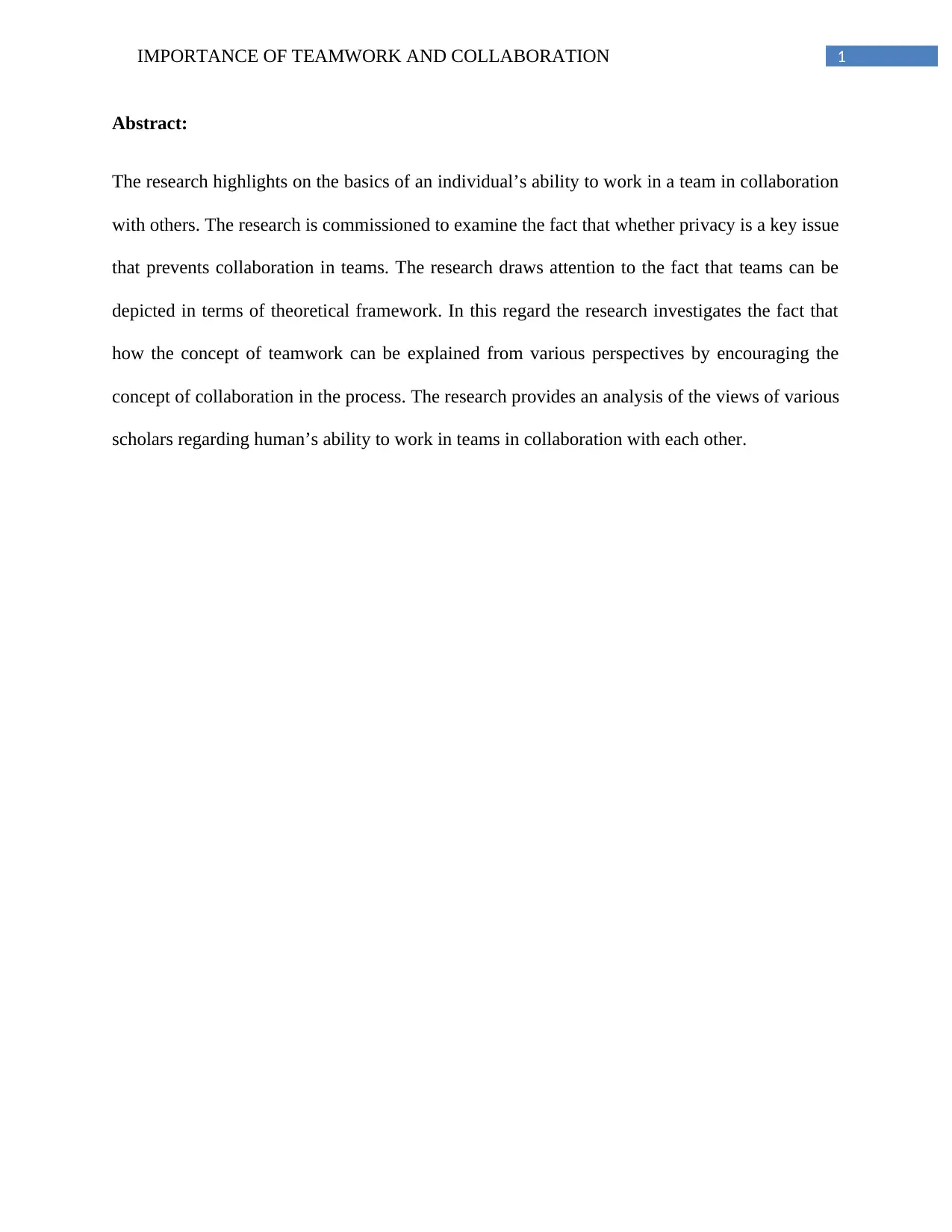
1IMPORTANCE OF TEAMWORK AND COLLABORATION
Abstract:
The research highlights on the basics of an individual’s ability to work in a team in collaboration
with others. The research is commissioned to examine the fact that whether privacy is a key issue
that prevents collaboration in teams. The research draws attention to the fact that teams can be
depicted in terms of theoretical framework. In this regard the research investigates the fact that
how the concept of teamwork can be explained from various perspectives by encouraging the
concept of collaboration in the process. The research provides an analysis of the views of various
scholars regarding human’s ability to work in teams in collaboration with each other.
Abstract:
The research highlights on the basics of an individual’s ability to work in a team in collaboration
with others. The research is commissioned to examine the fact that whether privacy is a key issue
that prevents collaboration in teams. The research draws attention to the fact that teams can be
depicted in terms of theoretical framework. In this regard the research investigates the fact that
how the concept of teamwork can be explained from various perspectives by encouraging the
concept of collaboration in the process. The research provides an analysis of the views of various
scholars regarding human’s ability to work in teams in collaboration with each other.
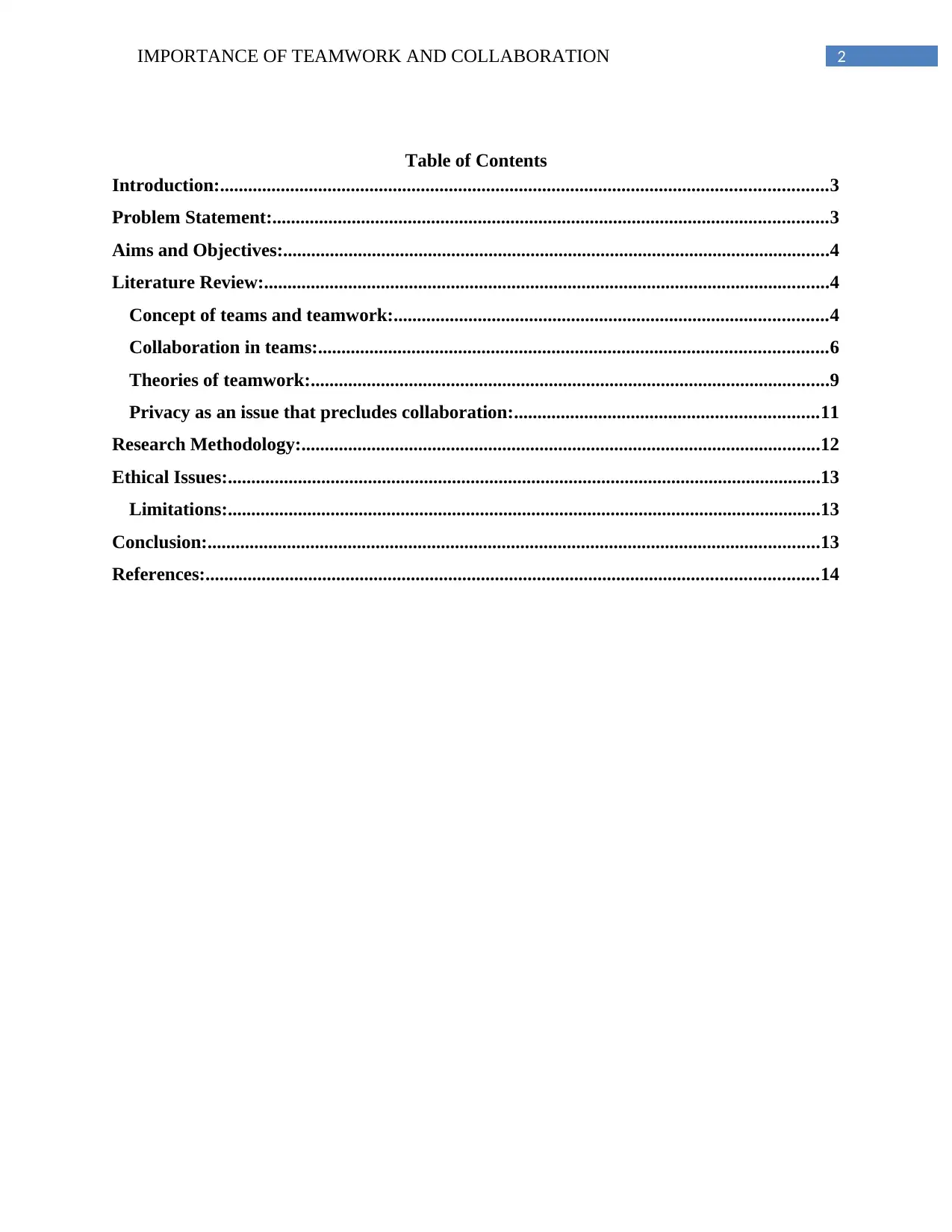
2IMPORTANCE OF TEAMWORK AND COLLABORATION
Table of Contents
Introduction:..................................................................................................................................3
Problem Statement:.......................................................................................................................3
Aims and Objectives:.....................................................................................................................4
Literature Review:.........................................................................................................................4
Concept of teams and teamwork:.............................................................................................4
Collaboration in teams:.............................................................................................................6
Theories of teamwork:...............................................................................................................9
Privacy as an issue that precludes collaboration:.................................................................11
Research Methodology:...............................................................................................................12
Ethical Issues:...............................................................................................................................13
Limitations:...............................................................................................................................13
Conclusion:...................................................................................................................................13
References:...................................................................................................................................14
Table of Contents
Introduction:..................................................................................................................................3
Problem Statement:.......................................................................................................................3
Aims and Objectives:.....................................................................................................................4
Literature Review:.........................................................................................................................4
Concept of teams and teamwork:.............................................................................................4
Collaboration in teams:.............................................................................................................6
Theories of teamwork:...............................................................................................................9
Privacy as an issue that precludes collaboration:.................................................................11
Research Methodology:...............................................................................................................12
Ethical Issues:...............................................................................................................................13
Limitations:...............................................................................................................................13
Conclusion:...................................................................................................................................13
References:...................................................................................................................................14
⊘ This is a preview!⊘
Do you want full access?
Subscribe today to unlock all pages.

Trusted by 1+ million students worldwide
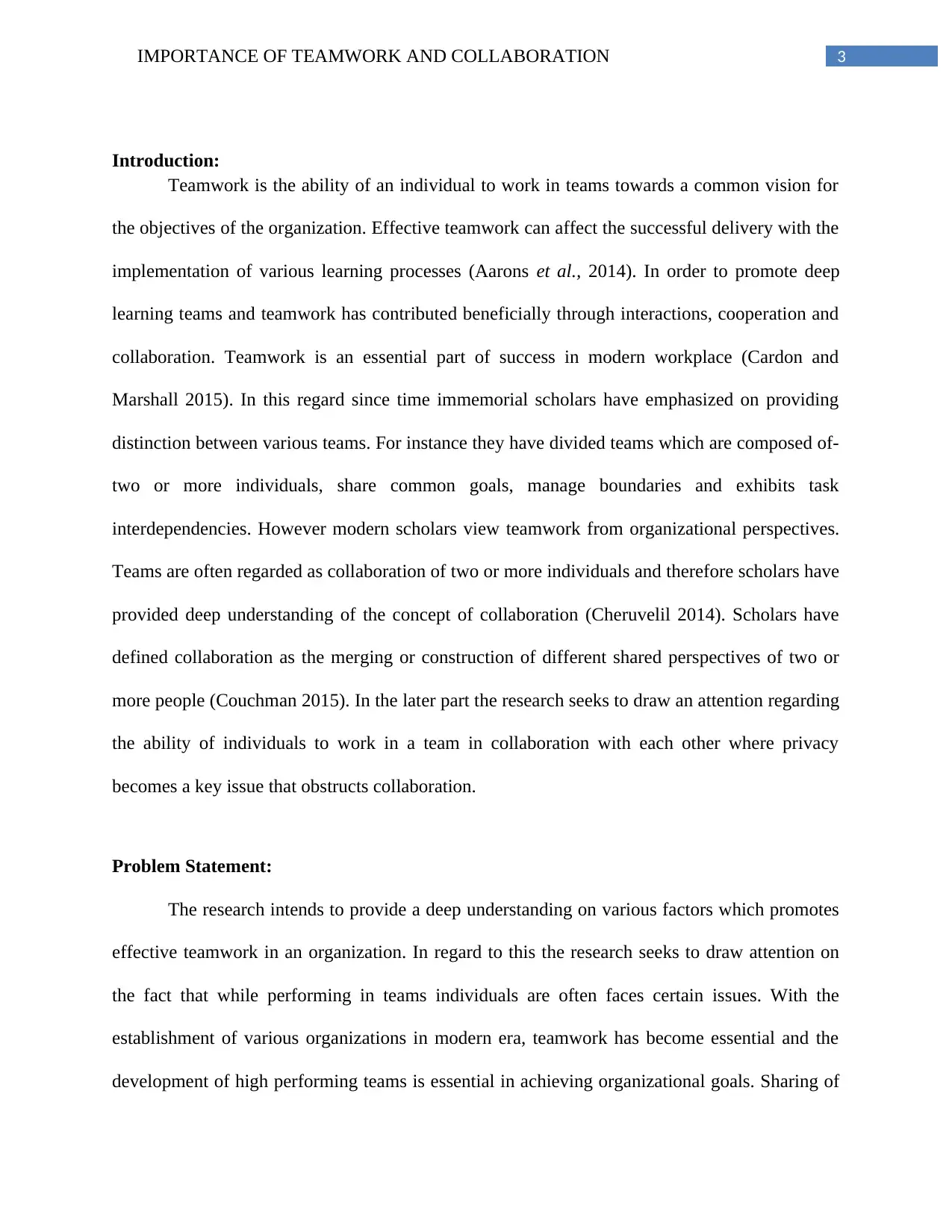
3IMPORTANCE OF TEAMWORK AND COLLABORATION
Introduction:
Teamwork is the ability of an individual to work in teams towards a common vision for
the objectives of the organization. Effective teamwork can affect the successful delivery with the
implementation of various learning processes (Aarons et al., 2014). In order to promote deep
learning teams and teamwork has contributed beneficially through interactions, cooperation and
collaboration. Teamwork is an essential part of success in modern workplace (Cardon and
Marshall 2015). In this regard since time immemorial scholars have emphasized on providing
distinction between various teams. For instance they have divided teams which are composed of-
two or more individuals, share common goals, manage boundaries and exhibits task
interdependencies. However modern scholars view teamwork from organizational perspectives.
Teams are often regarded as collaboration of two or more individuals and therefore scholars have
provided deep understanding of the concept of collaboration (Cheruvelil 2014). Scholars have
defined collaboration as the merging or construction of different shared perspectives of two or
more people (Couchman 2015). In the later part the research seeks to draw an attention regarding
the ability of individuals to work in a team in collaboration with each other where privacy
becomes a key issue that obstructs collaboration.
Problem Statement:
The research intends to provide a deep understanding on various factors which promotes
effective teamwork in an organization. In regard to this the research seeks to draw attention on
the fact that while performing in teams individuals are often faces certain issues. With the
establishment of various organizations in modern era, teamwork has become essential and the
development of high performing teams is essential in achieving organizational goals. Sharing of
Introduction:
Teamwork is the ability of an individual to work in teams towards a common vision for
the objectives of the organization. Effective teamwork can affect the successful delivery with the
implementation of various learning processes (Aarons et al., 2014). In order to promote deep
learning teams and teamwork has contributed beneficially through interactions, cooperation and
collaboration. Teamwork is an essential part of success in modern workplace (Cardon and
Marshall 2015). In this regard since time immemorial scholars have emphasized on providing
distinction between various teams. For instance they have divided teams which are composed of-
two or more individuals, share common goals, manage boundaries and exhibits task
interdependencies. However modern scholars view teamwork from organizational perspectives.
Teams are often regarded as collaboration of two or more individuals and therefore scholars have
provided deep understanding of the concept of collaboration (Cheruvelil 2014). Scholars have
defined collaboration as the merging or construction of different shared perspectives of two or
more people (Couchman 2015). In the later part the research seeks to draw an attention regarding
the ability of individuals to work in a team in collaboration with each other where privacy
becomes a key issue that obstructs collaboration.
Problem Statement:
The research intends to provide a deep understanding on various factors which promotes
effective teamwork in an organization. In regard to this the research seeks to draw attention on
the fact that while performing in teams individuals are often faces certain issues. With the
establishment of various organizations in modern era, teamwork has become essential and the
development of high performing teams is essential in achieving organizational goals. Sharing of
Paraphrase This Document
Need a fresh take? Get an instant paraphrase of this document with our AI Paraphraser
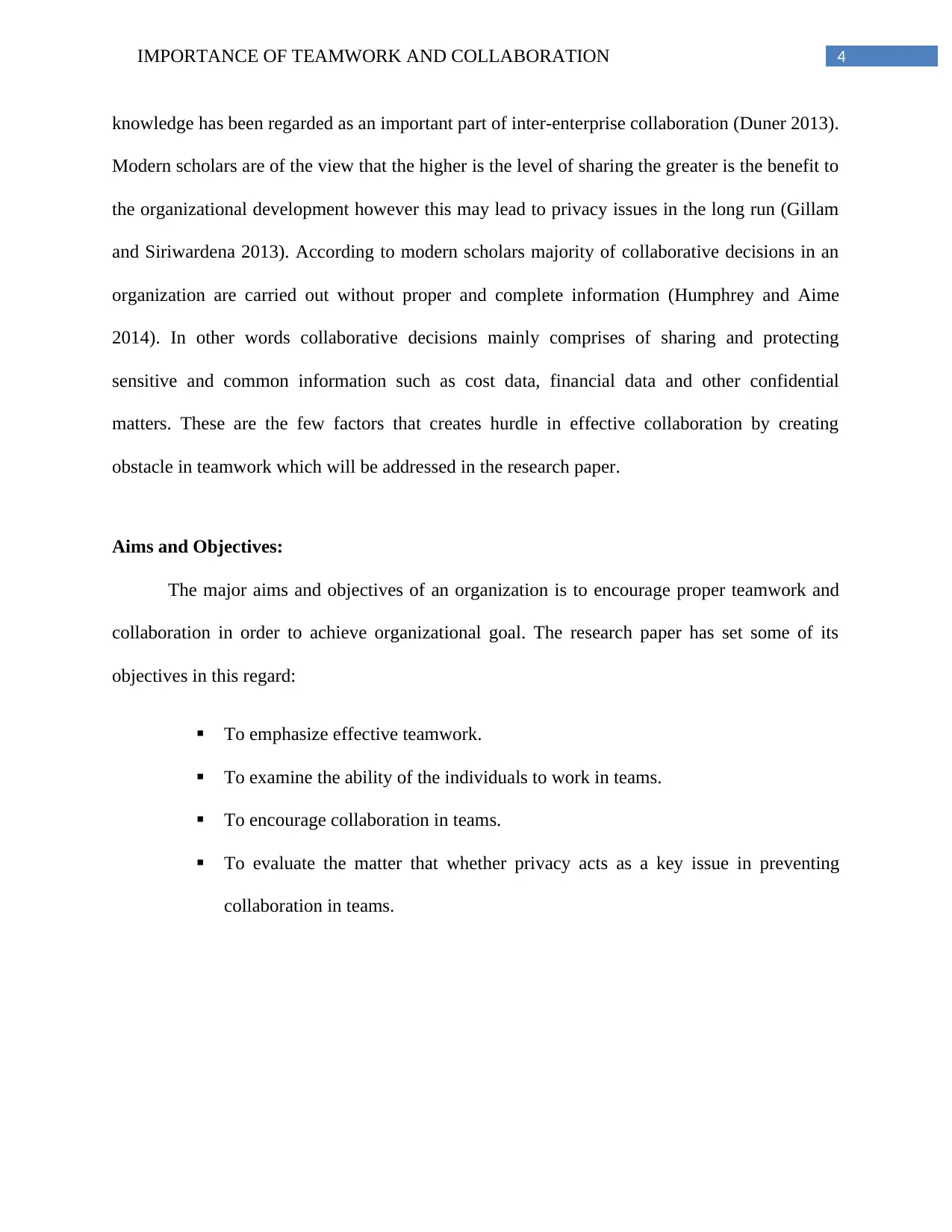
4IMPORTANCE OF TEAMWORK AND COLLABORATION
knowledge has been regarded as an important part of inter-enterprise collaboration (Duner 2013).
Modern scholars are of the view that the higher is the level of sharing the greater is the benefit to
the organizational development however this may lead to privacy issues in the long run (Gillam
and Siriwardena 2013). According to modern scholars majority of collaborative decisions in an
organization are carried out without proper and complete information (Humphrey and Aime
2014). In other words collaborative decisions mainly comprises of sharing and protecting
sensitive and common information such as cost data, financial data and other confidential
matters. These are the few factors that creates hurdle in effective collaboration by creating
obstacle in teamwork which will be addressed in the research paper.
Aims and Objectives:
The major aims and objectives of an organization is to encourage proper teamwork and
collaboration in order to achieve organizational goal. The research paper has set some of its
objectives in this regard:
To emphasize effective teamwork.
To examine the ability of the individuals to work in teams.
To encourage collaboration in teams.
To evaluate the matter that whether privacy acts as a key issue in preventing
collaboration in teams.
knowledge has been regarded as an important part of inter-enterprise collaboration (Duner 2013).
Modern scholars are of the view that the higher is the level of sharing the greater is the benefit to
the organizational development however this may lead to privacy issues in the long run (Gillam
and Siriwardena 2013). According to modern scholars majority of collaborative decisions in an
organization are carried out without proper and complete information (Humphrey and Aime
2014). In other words collaborative decisions mainly comprises of sharing and protecting
sensitive and common information such as cost data, financial data and other confidential
matters. These are the few factors that creates hurdle in effective collaboration by creating
obstacle in teamwork which will be addressed in the research paper.
Aims and Objectives:
The major aims and objectives of an organization is to encourage proper teamwork and
collaboration in order to achieve organizational goal. The research paper has set some of its
objectives in this regard:
To emphasize effective teamwork.
To examine the ability of the individuals to work in teams.
To encourage collaboration in teams.
To evaluate the matter that whether privacy acts as a key issue in preventing
collaboration in teams.
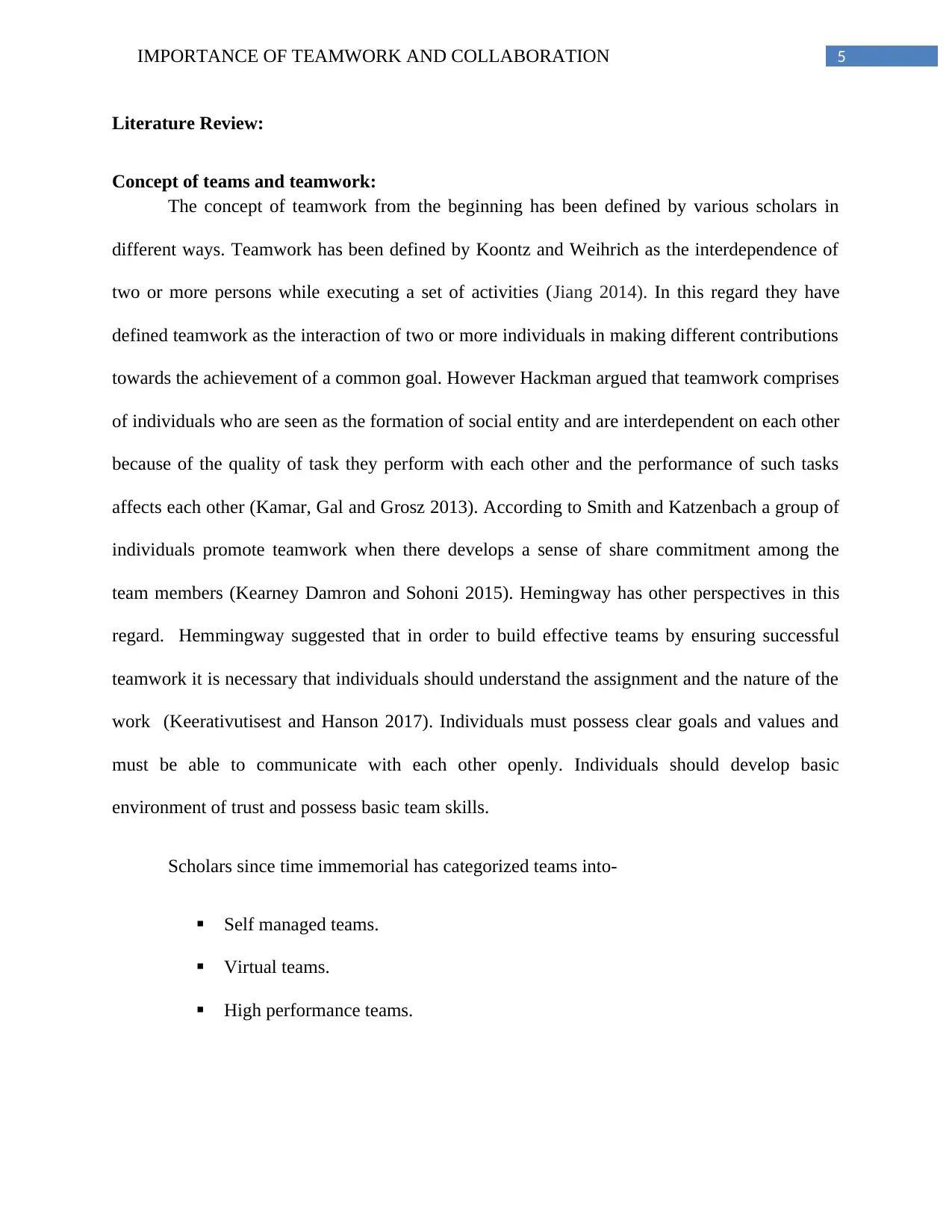
5IMPORTANCE OF TEAMWORK AND COLLABORATION
Literature Review:
Concept of teams and teamwork:
The concept of teamwork from the beginning has been defined by various scholars in
different ways. Teamwork has been defined by Koontz and Weihrich as the interdependence of
two or more persons while executing a set of activities (Jiang 2014). In this regard they have
defined teamwork as the interaction of two or more individuals in making different contributions
towards the achievement of a common goal. However Hackman argued that teamwork comprises
of individuals who are seen as the formation of social entity and are interdependent on each other
because of the quality of task they perform with each other and the performance of such tasks
affects each other (Kamar, Gal and Grosz 2013). According to Smith and Katzenbach a group of
individuals promote teamwork when there develops a sense of share commitment among the
team members (Kearney Damron and Sohoni 2015). Hemingway has other perspectives in this
regard. Hemmingway suggested that in order to build effective teams by ensuring successful
teamwork it is necessary that individuals should understand the assignment and the nature of the
work (Keerativutisest and Hanson 2017). Individuals must possess clear goals and values and
must be able to communicate with each other openly. Individuals should develop basic
environment of trust and possess basic team skills.
Scholars since time immemorial has categorized teams into-
Self managed teams.
Virtual teams.
High performance teams.
Literature Review:
Concept of teams and teamwork:
The concept of teamwork from the beginning has been defined by various scholars in
different ways. Teamwork has been defined by Koontz and Weihrich as the interdependence of
two or more persons while executing a set of activities (Jiang 2014). In this regard they have
defined teamwork as the interaction of two or more individuals in making different contributions
towards the achievement of a common goal. However Hackman argued that teamwork comprises
of individuals who are seen as the formation of social entity and are interdependent on each other
because of the quality of task they perform with each other and the performance of such tasks
affects each other (Kamar, Gal and Grosz 2013). According to Smith and Katzenbach a group of
individuals promote teamwork when there develops a sense of share commitment among the
team members (Kearney Damron and Sohoni 2015). Hemingway has other perspectives in this
regard. Hemmingway suggested that in order to build effective teams by ensuring successful
teamwork it is necessary that individuals should understand the assignment and the nature of the
work (Keerativutisest and Hanson 2017). Individuals must possess clear goals and values and
must be able to communicate with each other openly. Individuals should develop basic
environment of trust and possess basic team skills.
Scholars since time immemorial has categorized teams into-
Self managed teams.
Virtual teams.
High performance teams.
⊘ This is a preview!⊘
Do you want full access?
Subscribe today to unlock all pages.

Trusted by 1+ million students worldwide
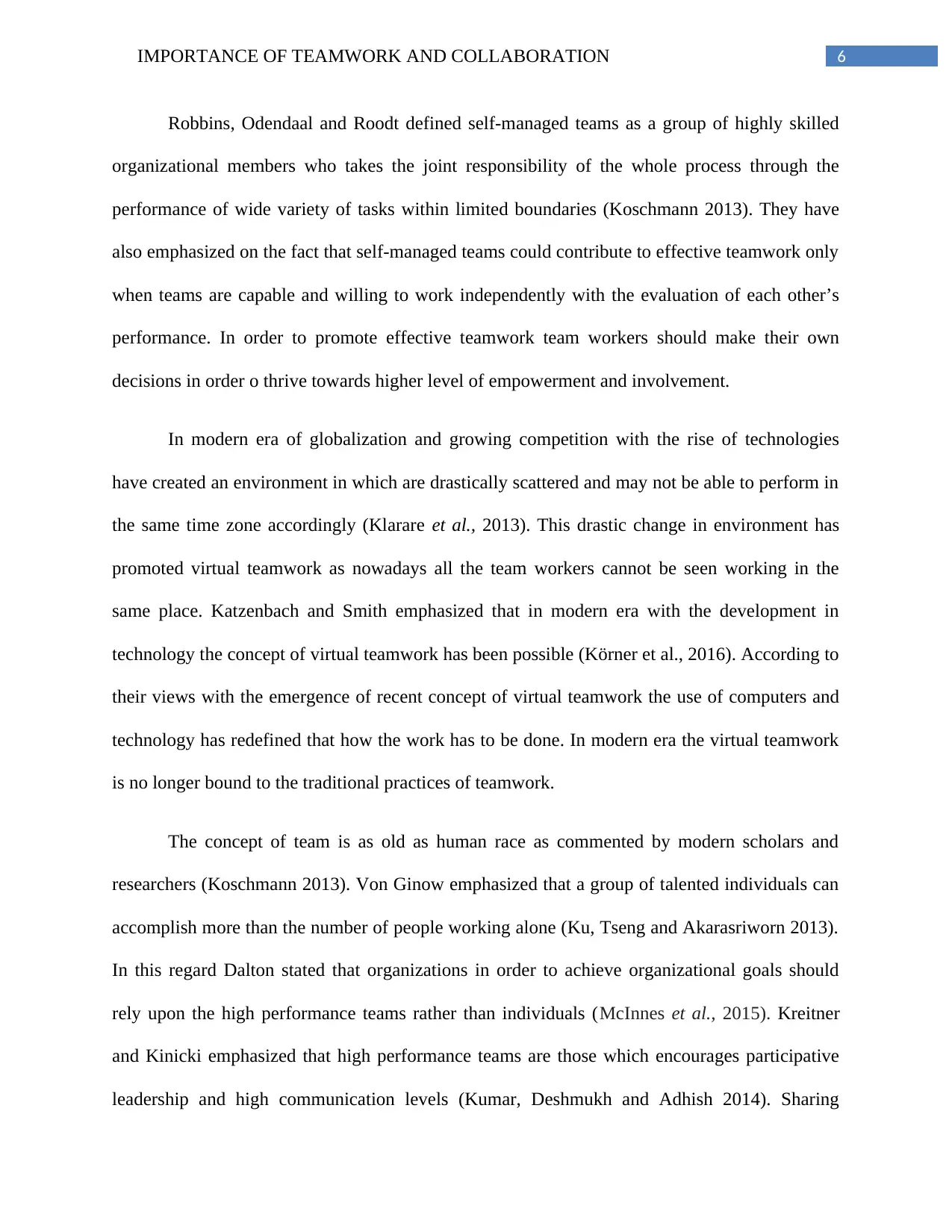
6IMPORTANCE OF TEAMWORK AND COLLABORATION
Robbins, Odendaal and Roodt defined self-managed teams as a group of highly skilled
organizational members who takes the joint responsibility of the whole process through the
performance of wide variety of tasks within limited boundaries (Koschmann 2013). They have
also emphasized on the fact that self-managed teams could contribute to effective teamwork only
when teams are capable and willing to work independently with the evaluation of each other’s
performance. In order to promote effective teamwork team workers should make their own
decisions in order o thrive towards higher level of empowerment and involvement.
In modern era of globalization and growing competition with the rise of technologies
have created an environment in which are drastically scattered and may not be able to perform in
the same time zone accordingly (Klarare et al., 2013). This drastic change in environment has
promoted virtual teamwork as nowadays all the team workers cannot be seen working in the
same place. Katzenbach and Smith emphasized that in modern era with the development in
technology the concept of virtual teamwork has been possible (Körner et al., 2016). According to
their views with the emergence of recent concept of virtual teamwork the use of computers and
technology has redefined that how the work has to be done. In modern era the virtual teamwork
is no longer bound to the traditional practices of teamwork.
The concept of team is as old as human race as commented by modern scholars and
researchers (Koschmann 2013). Von Ginow emphasized that a group of talented individuals can
accomplish more than the number of people working alone (Ku, Tseng and Akarasriworn 2013).
In this regard Dalton stated that organizations in order to achieve organizational goals should
rely upon the high performance teams rather than individuals (McInnes et al., 2015). Kreitner
and Kinicki emphasized that high performance teams are those which encourages participative
leadership and high communication levels (Kumar, Deshmukh and Adhish 2014). Sharing
Robbins, Odendaal and Roodt defined self-managed teams as a group of highly skilled
organizational members who takes the joint responsibility of the whole process through the
performance of wide variety of tasks within limited boundaries (Koschmann 2013). They have
also emphasized on the fact that self-managed teams could contribute to effective teamwork only
when teams are capable and willing to work independently with the evaluation of each other’s
performance. In order to promote effective teamwork team workers should make their own
decisions in order o thrive towards higher level of empowerment and involvement.
In modern era of globalization and growing competition with the rise of technologies
have created an environment in which are drastically scattered and may not be able to perform in
the same time zone accordingly (Klarare et al., 2013). This drastic change in environment has
promoted virtual teamwork as nowadays all the team workers cannot be seen working in the
same place. Katzenbach and Smith emphasized that in modern era with the development in
technology the concept of virtual teamwork has been possible (Körner et al., 2016). According to
their views with the emergence of recent concept of virtual teamwork the use of computers and
technology has redefined that how the work has to be done. In modern era the virtual teamwork
is no longer bound to the traditional practices of teamwork.
The concept of team is as old as human race as commented by modern scholars and
researchers (Koschmann 2013). Von Ginow emphasized that a group of talented individuals can
accomplish more than the number of people working alone (Ku, Tseng and Akarasriworn 2013).
In this regard Dalton stated that organizations in order to achieve organizational goals should
rely upon the high performance teams rather than individuals (McInnes et al., 2015). Kreitner
and Kinicki emphasized that high performance teams are those which encourages participative
leadership and high communication levels (Kumar, Deshmukh and Adhish 2014). Sharing
Paraphrase This Document
Need a fresh take? Get an instant paraphrase of this document with our AI Paraphraser
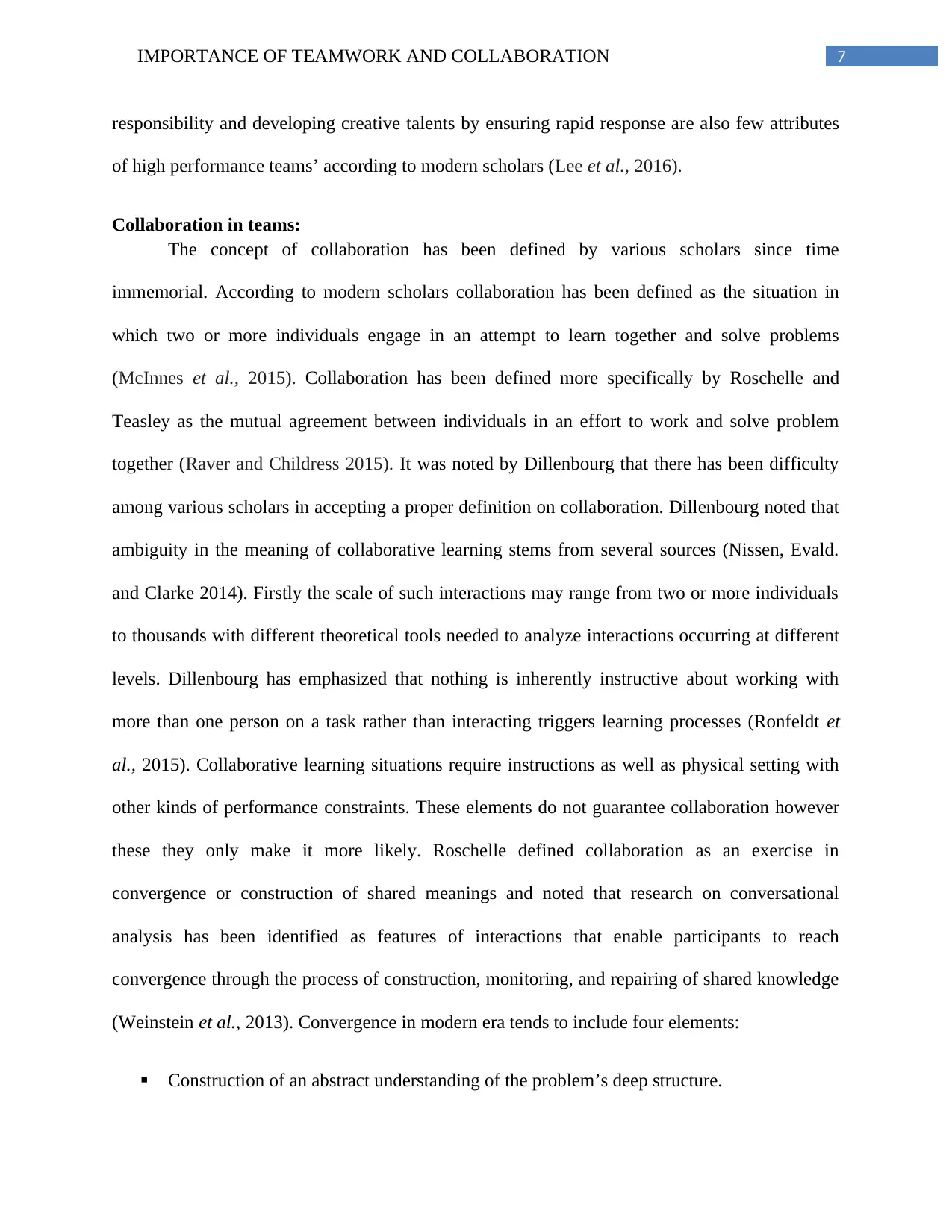
7IMPORTANCE OF TEAMWORK AND COLLABORATION
responsibility and developing creative talents by ensuring rapid response are also few attributes
of high performance teams’ according to modern scholars (Lee et al., 2016).
Collaboration in teams:
The concept of collaboration has been defined by various scholars since time
immemorial. According to modern scholars collaboration has been defined as the situation in
which two or more individuals engage in an attempt to learn together and solve problems
(McInnes et al., 2015). Collaboration has been defined more specifically by Roschelle and
Teasley as the mutual agreement between individuals in an effort to work and solve problem
together (Raver and Childress 2015). It was noted by Dillenbourg that there has been difficulty
among various scholars in accepting a proper definition on collaboration. Dillenbourg noted that
ambiguity in the meaning of collaborative learning stems from several sources (Nissen, Evald.
and Clarke 2014). Firstly the scale of such interactions may range from two or more individuals
to thousands with different theoretical tools needed to analyze interactions occurring at different
levels. Dillenbourg has emphasized that nothing is inherently instructive about working with
more than one person on a task rather than interacting triggers learning processes (Ronfeldt et
al., 2015). Collaborative learning situations require instructions as well as physical setting with
other kinds of performance constraints. These elements do not guarantee collaboration however
these they only make it more likely. Roschelle defined collaboration as an exercise in
convergence or construction of shared meanings and noted that research on conversational
analysis has been identified as features of interactions that enable participants to reach
convergence through the process of construction, monitoring, and repairing of shared knowledge
(Weinstein et al., 2013). Convergence in modern era tends to include four elements:
Construction of an abstract understanding of the problem’s deep structure.
responsibility and developing creative talents by ensuring rapid response are also few attributes
of high performance teams’ according to modern scholars (Lee et al., 2016).
Collaboration in teams:
The concept of collaboration has been defined by various scholars since time
immemorial. According to modern scholars collaboration has been defined as the situation in
which two or more individuals engage in an attempt to learn together and solve problems
(McInnes et al., 2015). Collaboration has been defined more specifically by Roschelle and
Teasley as the mutual agreement between individuals in an effort to work and solve problem
together (Raver and Childress 2015). It was noted by Dillenbourg that there has been difficulty
among various scholars in accepting a proper definition on collaboration. Dillenbourg noted that
ambiguity in the meaning of collaborative learning stems from several sources (Nissen, Evald.
and Clarke 2014). Firstly the scale of such interactions may range from two or more individuals
to thousands with different theoretical tools needed to analyze interactions occurring at different
levels. Dillenbourg has emphasized that nothing is inherently instructive about working with
more than one person on a task rather than interacting triggers learning processes (Ronfeldt et
al., 2015). Collaborative learning situations require instructions as well as physical setting with
other kinds of performance constraints. These elements do not guarantee collaboration however
these they only make it more likely. Roschelle defined collaboration as an exercise in
convergence or construction of shared meanings and noted that research on conversational
analysis has been identified as features of interactions that enable participants to reach
convergence through the process of construction, monitoring, and repairing of shared knowledge
(Weinstein et al., 2013). Convergence in modern era tends to include four elements:
Construction of an abstract understanding of the problem’s deep structure.
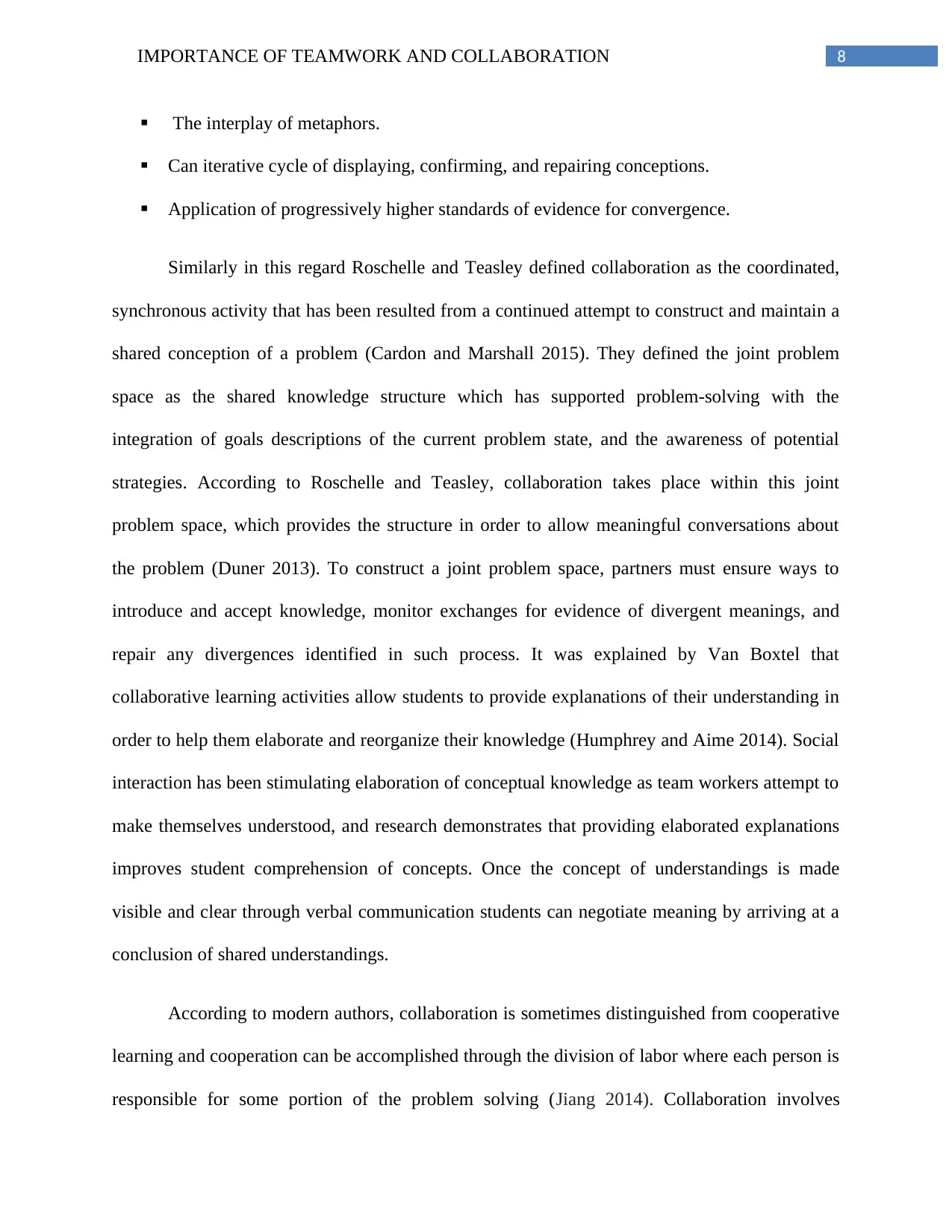
8IMPORTANCE OF TEAMWORK AND COLLABORATION
The interplay of metaphors.
Can iterative cycle of displaying, confirming, and repairing conceptions.
Application of progressively higher standards of evidence for convergence.
Similarly in this regard Roschelle and Teasley defined collaboration as the coordinated,
synchronous activity that has been resulted from a continued attempt to construct and maintain a
shared conception of a problem (Cardon and Marshall 2015). They defined the joint problem
space as the shared knowledge structure which has supported problem-solving with the
integration of goals descriptions of the current problem state, and the awareness of potential
strategies. According to Roschelle and Teasley, collaboration takes place within this joint
problem space, which provides the structure in order to allow meaningful conversations about
the problem (Duner 2013). To construct a joint problem space, partners must ensure ways to
introduce and accept knowledge, monitor exchanges for evidence of divergent meanings, and
repair any divergences identified in such process. It was explained by Van Boxtel that
collaborative learning activities allow students to provide explanations of their understanding in
order to help them elaborate and reorganize their knowledge (Humphrey and Aime 2014). Social
interaction has been stimulating elaboration of conceptual knowledge as team workers attempt to
make themselves understood, and research demonstrates that providing elaborated explanations
improves student comprehension of concepts. Once the concept of understandings is made
visible and clear through verbal communication students can negotiate meaning by arriving at a
conclusion of shared understandings.
According to modern authors, collaboration is sometimes distinguished from cooperative
learning and cooperation can be accomplished through the division of labor where each person is
responsible for some portion of the problem solving (Jiang 2014). Collaboration involves
The interplay of metaphors.
Can iterative cycle of displaying, confirming, and repairing conceptions.
Application of progressively higher standards of evidence for convergence.
Similarly in this regard Roschelle and Teasley defined collaboration as the coordinated,
synchronous activity that has been resulted from a continued attempt to construct and maintain a
shared conception of a problem (Cardon and Marshall 2015). They defined the joint problem
space as the shared knowledge structure which has supported problem-solving with the
integration of goals descriptions of the current problem state, and the awareness of potential
strategies. According to Roschelle and Teasley, collaboration takes place within this joint
problem space, which provides the structure in order to allow meaningful conversations about
the problem (Duner 2013). To construct a joint problem space, partners must ensure ways to
introduce and accept knowledge, monitor exchanges for evidence of divergent meanings, and
repair any divergences identified in such process. It was explained by Van Boxtel that
collaborative learning activities allow students to provide explanations of their understanding in
order to help them elaborate and reorganize their knowledge (Humphrey and Aime 2014). Social
interaction has been stimulating elaboration of conceptual knowledge as team workers attempt to
make themselves understood, and research demonstrates that providing elaborated explanations
improves student comprehension of concepts. Once the concept of understandings is made
visible and clear through verbal communication students can negotiate meaning by arriving at a
conclusion of shared understandings.
According to modern authors, collaboration is sometimes distinguished from cooperative
learning and cooperation can be accomplished through the division of labor where each person is
responsible for some portion of the problem solving (Jiang 2014). Collaboration involves
⊘ This is a preview!⊘
Do you want full access?
Subscribe today to unlock all pages.

Trusted by 1+ million students worldwide
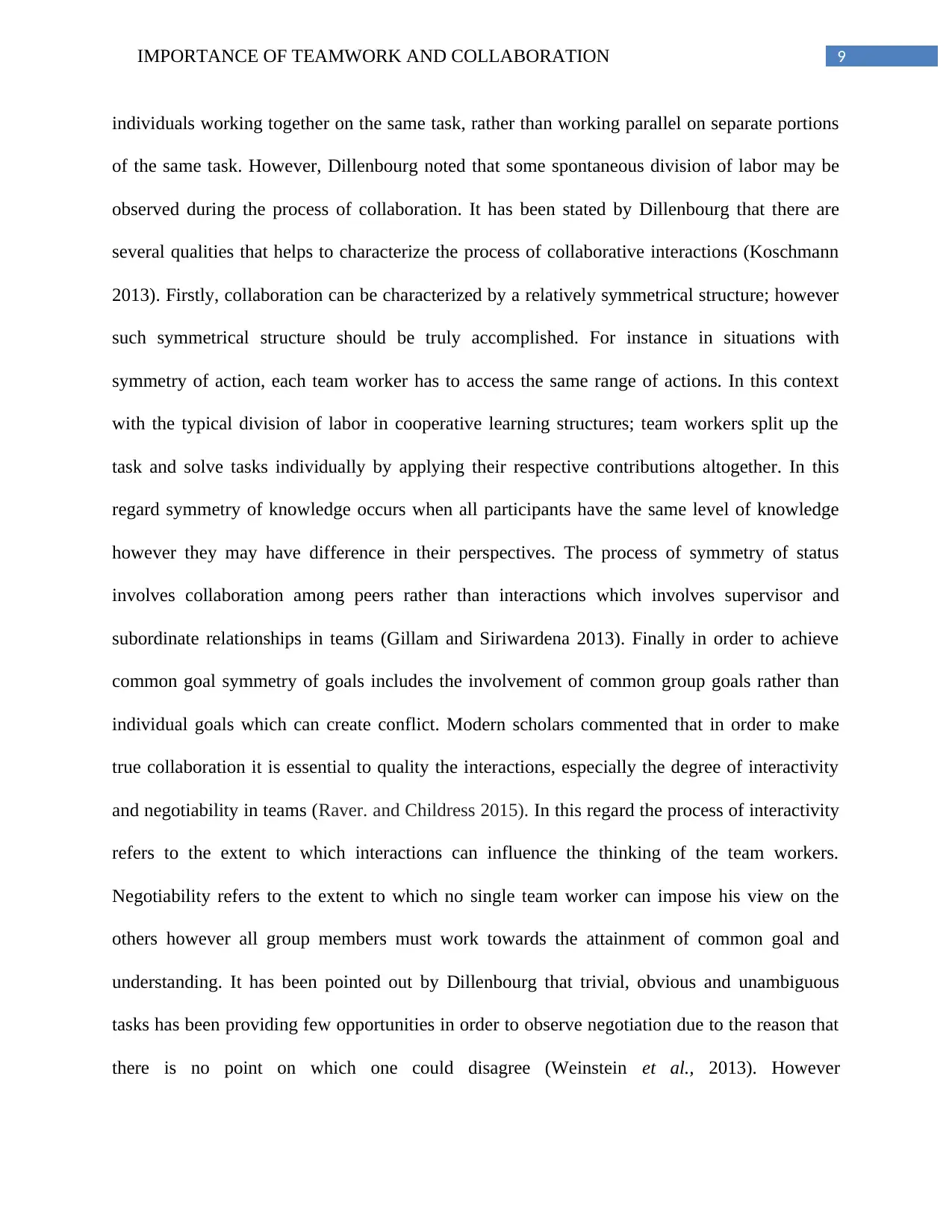
9IMPORTANCE OF TEAMWORK AND COLLABORATION
individuals working together on the same task, rather than working parallel on separate portions
of the same task. However, Dillenbourg noted that some spontaneous division of labor may be
observed during the process of collaboration. It has been stated by Dillenbourg that there are
several qualities that helps to characterize the process of collaborative interactions (Koschmann
2013). Firstly, collaboration can be characterized by a relatively symmetrical structure; however
such symmetrical structure should be truly accomplished. For instance in situations with
symmetry of action, each team worker has to access the same range of actions. In this context
with the typical division of labor in cooperative learning structures; team workers split up the
task and solve tasks individually by applying their respective contributions altogether. In this
regard symmetry of knowledge occurs when all participants have the same level of knowledge
however they may have difference in their perspectives. The process of symmetry of status
involves collaboration among peers rather than interactions which involves supervisor and
subordinate relationships in teams (Gillam and Siriwardena 2013). Finally in order to achieve
common goal symmetry of goals includes the involvement of common group goals rather than
individual goals which can create conflict. Modern scholars commented that in order to make
true collaboration it is essential to quality the interactions, especially the degree of interactivity
and negotiability in teams (Raver. and Childress 2015). In this regard the process of interactivity
refers to the extent to which interactions can influence the thinking of the team workers.
Negotiability refers to the extent to which no single team worker can impose his view on the
others however all group members must work towards the attainment of common goal and
understanding. It has been pointed out by Dillenbourg that trivial, obvious and unambiguous
tasks has been providing few opportunities in order to observe negotiation due to the reason that
there is no point on which one could disagree (Weinstein et al., 2013). However
individuals working together on the same task, rather than working parallel on separate portions
of the same task. However, Dillenbourg noted that some spontaneous division of labor may be
observed during the process of collaboration. It has been stated by Dillenbourg that there are
several qualities that helps to characterize the process of collaborative interactions (Koschmann
2013). Firstly, collaboration can be characterized by a relatively symmetrical structure; however
such symmetrical structure should be truly accomplished. For instance in situations with
symmetry of action, each team worker has to access the same range of actions. In this context
with the typical division of labor in cooperative learning structures; team workers split up the
task and solve tasks individually by applying their respective contributions altogether. In this
regard symmetry of knowledge occurs when all participants have the same level of knowledge
however they may have difference in their perspectives. The process of symmetry of status
involves collaboration among peers rather than interactions which involves supervisor and
subordinate relationships in teams (Gillam and Siriwardena 2013). Finally in order to achieve
common goal symmetry of goals includes the involvement of common group goals rather than
individual goals which can create conflict. Modern scholars commented that in order to make
true collaboration it is essential to quality the interactions, especially the degree of interactivity
and negotiability in teams (Raver. and Childress 2015). In this regard the process of interactivity
refers to the extent to which interactions can influence the thinking of the team workers.
Negotiability refers to the extent to which no single team worker can impose his view on the
others however all group members must work towards the attainment of common goal and
understanding. It has been pointed out by Dillenbourg that trivial, obvious and unambiguous
tasks has been providing few opportunities in order to observe negotiation due to the reason that
there is no point on which one could disagree (Weinstein et al., 2013). However
Paraphrase This Document
Need a fresh take? Get an instant paraphrase of this document with our AI Paraphraser
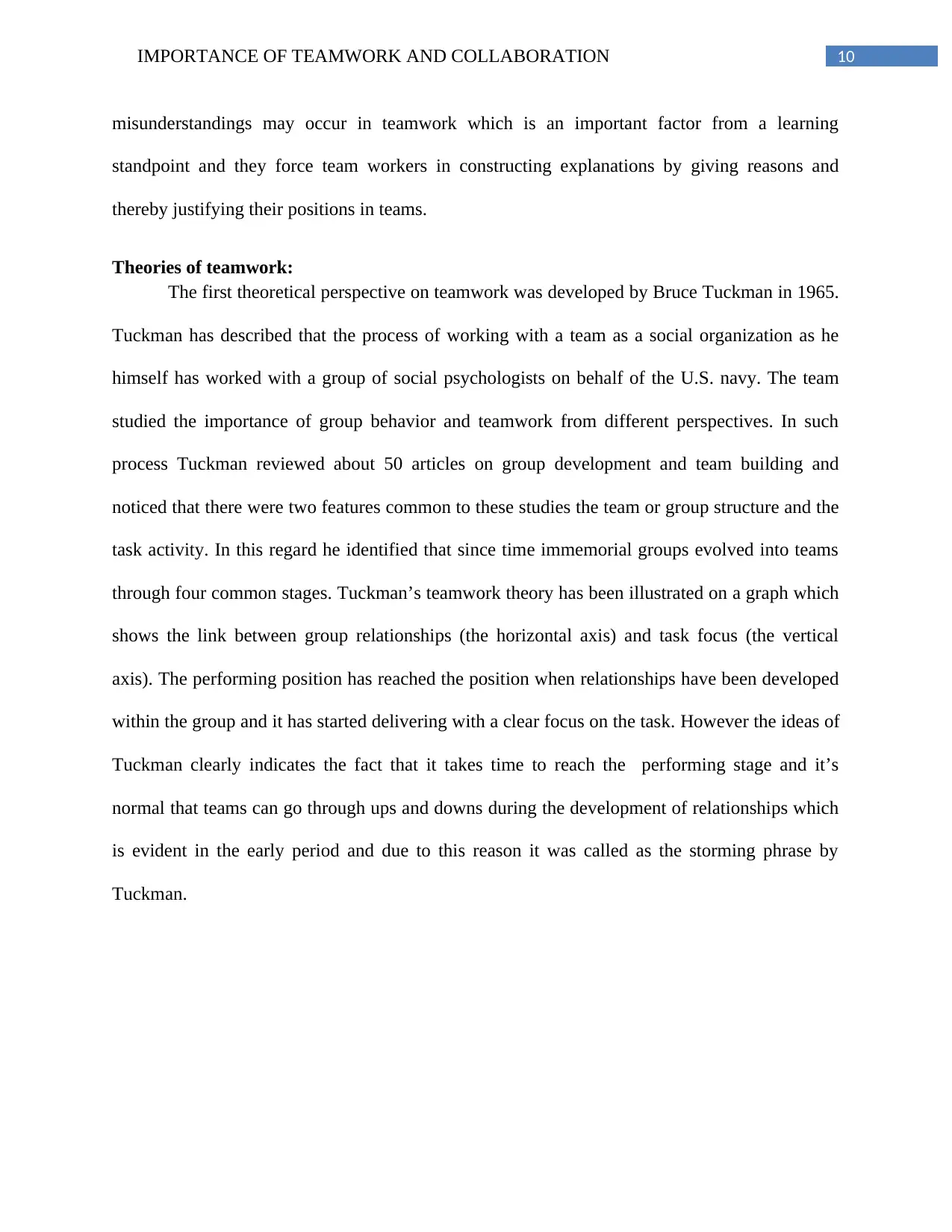
10IMPORTANCE OF TEAMWORK AND COLLABORATION
misunderstandings may occur in teamwork which is an important factor from a learning
standpoint and they force team workers in constructing explanations by giving reasons and
thereby justifying their positions in teams.
Theories of teamwork:
The first theoretical perspective on teamwork was developed by Bruce Tuckman in 1965.
Tuckman has described that the process of working with a team as a social organization as he
himself has worked with a group of social psychologists on behalf of the U.S. navy. The team
studied the importance of group behavior and teamwork from different perspectives. In such
process Tuckman reviewed about 50 articles on group development and team building and
noticed that there were two features common to these studies the team or group structure and the
task activity. In this regard he identified that since time immemorial groups evolved into teams
through four common stages. Tuckman’s teamwork theory has been illustrated on a graph which
shows the link between group relationships (the horizontal axis) and task focus (the vertical
axis). The performing position has reached the position when relationships have been developed
within the group and it has started delivering with a clear focus on the task. However the ideas of
Tuckman clearly indicates the fact that it takes time to reach the performing stage and it’s
normal that teams can go through ups and downs during the development of relationships which
is evident in the early period and due to this reason it was called as the storming phrase by
Tuckman.
misunderstandings may occur in teamwork which is an important factor from a learning
standpoint and they force team workers in constructing explanations by giving reasons and
thereby justifying their positions in teams.
Theories of teamwork:
The first theoretical perspective on teamwork was developed by Bruce Tuckman in 1965.
Tuckman has described that the process of working with a team as a social organization as he
himself has worked with a group of social psychologists on behalf of the U.S. navy. The team
studied the importance of group behavior and teamwork from different perspectives. In such
process Tuckman reviewed about 50 articles on group development and team building and
noticed that there were two features common to these studies the team or group structure and the
task activity. In this regard he identified that since time immemorial groups evolved into teams
through four common stages. Tuckman’s teamwork theory has been illustrated on a graph which
shows the link between group relationships (the horizontal axis) and task focus (the vertical
axis). The performing position has reached the position when relationships have been developed
within the group and it has started delivering with a clear focus on the task. However the ideas of
Tuckman clearly indicates the fact that it takes time to reach the performing stage and it’s
normal that teams can go through ups and downs during the development of relationships which
is evident in the early period and due to this reason it was called as the storming phrase by
Tuckman.
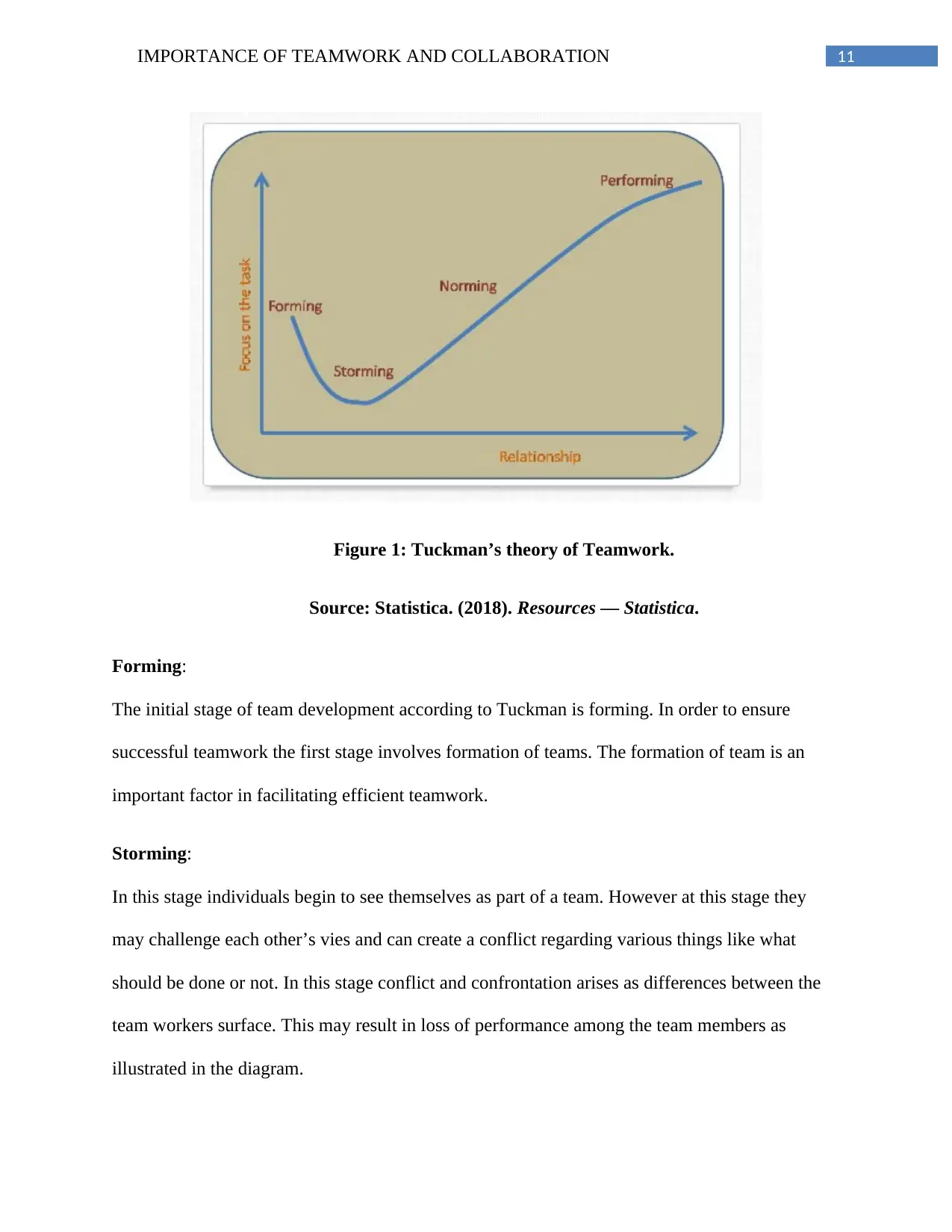
11IMPORTANCE OF TEAMWORK AND COLLABORATION
Figure 1: Tuckman’s theory of Teamwork.
Source: Statistica. (2018). Resources — Statistica.
Forming:
The initial stage of team development according to Tuckman is forming. In order to ensure
successful teamwork the first stage involves formation of teams. The formation of team is an
important factor in facilitating efficient teamwork.
Storming:
In this stage individuals begin to see themselves as part of a team. However at this stage they
may challenge each other’s vies and can create a conflict regarding various things like what
should be done or not. In this stage conflict and confrontation arises as differences between the
team workers surface. This may result in loss of performance among the team members as
illustrated in the diagram.
Figure 1: Tuckman’s theory of Teamwork.
Source: Statistica. (2018). Resources — Statistica.
Forming:
The initial stage of team development according to Tuckman is forming. In order to ensure
successful teamwork the first stage involves formation of teams. The formation of team is an
important factor in facilitating efficient teamwork.
Storming:
In this stage individuals begin to see themselves as part of a team. However at this stage they
may challenge each other’s vies and can create a conflict regarding various things like what
should be done or not. In this stage conflict and confrontation arises as differences between the
team workers surface. This may result in loss of performance among the team members as
illustrated in the diagram.
⊘ This is a preview!⊘
Do you want full access?
Subscribe today to unlock all pages.

Trusted by 1+ million students worldwide
1 out of 19
Related Documents
Your All-in-One AI-Powered Toolkit for Academic Success.
+13062052269
info@desklib.com
Available 24*7 on WhatsApp / Email
![[object Object]](/_next/static/media/star-bottom.7253800d.svg)
Unlock your academic potential
Copyright © 2020–2025 A2Z Services. All Rights Reserved. Developed and managed by ZUCOL.




